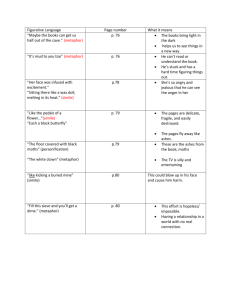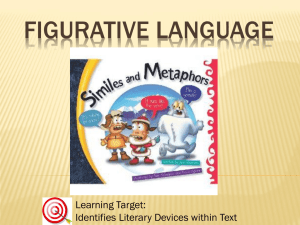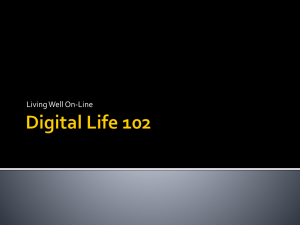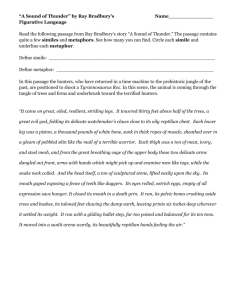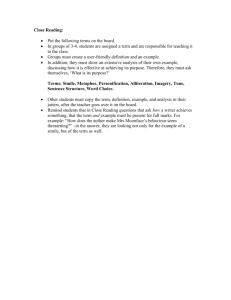Figures of Speech
advertisement
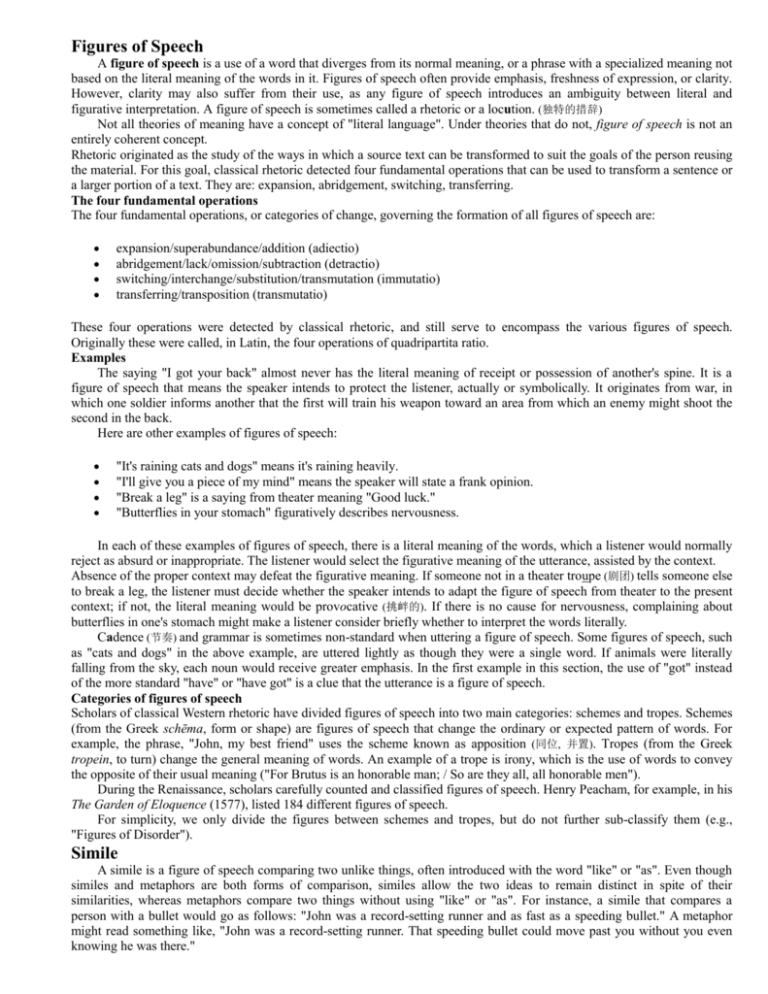
Figures of Speech A figure of speech is a use of a word that diverges from its normal meaning, or a phrase with a specialized meaning not based on the literal meaning of the words in it. Figures of speech often provide emphasis, freshness of expression, or clarity. However, clarity may also suffer from their use, as any figure of speech introduces an ambiguity between literal and figurative interpretation. A figure of speech is sometimes called a rhetoric or a locution. (独特的措辞) Not all theories of meaning have a concept of "literal language". Under theories that do not, figure of speech is not an entirely coherent concept. Rhetoric originated as the study of the ways in which a source text can be transformed to suit the goals of the person reusing the material. For this goal, classical rhetoric detected four fundamental operations that can be used to transform a sentence or a larger portion of a text. They are: expansion, abridgement, switching, transferring. The four fundamental operations The four fundamental operations, or categories of change, governing the formation of all figures of speech are: expansion/superabundance/addition (adiectio) abridgement/lack/omission/subtraction (detractio) switching/interchange/substitution/transmutation (immutatio) transferring/transposition (transmutatio) These four operations were detected by classical rhetoric, and still serve to encompass the various figures of speech. Originally these were called, in Latin, the four operations of quadripartita ratio. Examples The saying "I got your back" almost never has the literal meaning of receipt or possession of another's spine. It is a figure of speech that means the speaker intends to protect the listener, actually or symbolically. It originates from war, in which one soldier informs another that the first will train his weapon toward an area from which an enemy might shoot the second in the back. Here are other examples of figures of speech: "It's raining cats and dogs" means it's raining heavily. "I'll give you a piece of my mind" means the speaker will state a frank opinion. "Break a leg" is a saying from theater meaning "Good luck." "Butterflies in your stomach" figuratively describes nervousness. In each of these examples of figures of speech, there is a literal meaning of the words, which a listener would normally reject as absurd or inappropriate. The listener would select the figurative meaning of the utterance, assisted by the context. Absence of the proper context may defeat the figurative meaning. If someone not in a theater troupe (剧团) tells someone else to break a leg, the listener must decide whether the speaker intends to adapt the figure of speech from theater to the present context; if not, the literal meaning would be provocative (挑衅的). If there is no cause for nervousness, complaining about butterflies in one's stomach might make a listener consider briefly whether to interpret the words literally. Cadence (节奏) and grammar is sometimes non-standard when uttering a figure of speech. Some figures of speech, such as "cats and dogs" in the above example, are uttered lightly as though they were a single word. If animals were literally falling from the sky, each noun would receive greater emphasis. In the first example in this section, the use of "got" instead of the more standard "have" or "have got" is a clue that the utterance is a figure of speech. Categories of figures of speech Scholars of classical Western rhetoric have divided figures of speech into two main categories: schemes and tropes. Schemes (from the Greek schēma, form or shape) are figures of speech that change the ordinary or expected pattern of words. For example, the phrase, "John, my best friend" uses the scheme known as apposition (同位, 并置). Tropes (from the Greek tropein, to turn) change the general meaning of words. An example of a trope is irony, which is the use of words to convey the opposite of their usual meaning ("For Brutus is an honorable man; / So are they all, all honorable men"). During the Renaissance, scholars carefully counted and classified figures of speech. Henry Peacham, for example, in his The Garden of Eloquence (1577), listed 184 different figures of speech. For simplicity, we only divide the figures between schemes and tropes, but do not further sub-classify them (e.g., "Figures of Disorder"). Simile A simile is a figure of speech comparing two unlike things, often introduced with the word "like" or "as". Even though similes and metaphors are both forms of comparison, similes allow the two ideas to remain distinct in spite of their similarities, whereas metaphors compare two things without using "like" or "as". For instance, a simile that compares a person with a bullet would go as follows: "John was a record-setting runner and as fast as a speeding bullet." A metaphor might read something like, "John was a record-setting runner. That speeding bullet could move past you without you even knowing he was there." A mnemonic (一种帮助记忆的方法) for a simile is that "a simile is similar or alike." Similes have been widely used in literature for their expressiveness as a figure of speech: Curley was flopping like a fish on a line. The very mist on the Essex marshes was like a gauzy (纱似的) and radiant fabric. Why, man, he doth get on the narrow world like a Colossus (巨人). Explicit similes A simile can explicitly provide the basis of a comparison or leave this basis implicit. For instance, the following similes are implicit, leaving an audience to determine for themselves which features are being predicated of a target: "My dad was a mechanic by trade when he was in the Army," Raymond Thompson said. "When he got the tools out, he was like a surgeon." More detail is present in the following similes, but it is still a matter of inference as to what features are actually predicated of the target: He fights like a lion. He swims as fast as a fish. He slides like a snake. He runs like a cheetah (印度豹). In contrast, the following similes explicitly state the features that are predicated of each target: When he got the tools out, he was as precise and thorough as a surgeon. He drinks abundantly like a fish. She walks as gracefully and elegantly as a cat. He was as a lion in the fight. They fought like they were warriors Unlike a metaphor, a simile can be as precise as the user needs it to be, to explicitly predicate a single feature of a target or to vaguely predicate an under-determined and open-ended body of features. Empirical research supports the observation that similes are more likely to be used with explicit explanations of their intended meaning; this offers some support to the claim that similes are preferred if a user wants to associate an unusual or out-of-the-ordinary property with a target. Stereotypes The most commonplace similes offer a window into the stereotypes that pervade a given language and culture. For example, the following similes convey a stereotypical view of people, animals and things: as precise as a surgeon as regular as a clock as cunning as a fox as ugly as a toad as strong as an ox as sour as vinegar as flexible as a panther as quiet as a mouse as bumpy as a gravel road These similes have the status of a cliché or platitude (陈词滥调) in English, and their use is typically taken to signify a lack of creative imagination. Some stereotypical similes express viewpoints that are technically incorrect but which are widespread in a culture, such as: as cruel as a wolf as stubborn as a goat as drunk as a skunk (臭鼬) as violent as a gorilla as slow as a sloth (树懒) as proud as a peacock Animal stereotypes provide a rich vein of similes in English, as does a persistent body of ethnic stereotypes. Similes do not have to be accurate to be meaningful or useful. To be "as proud as a peacock" is "to be very proud" whether peacocks actually do exhibit pride or not. What matters is that peacocks are commonly believed to be exemplary examples of proud behaviour. Metaphor metaphor (from Latin metaphoria) is a figure of speech and or phrase that one word as being or equal to a second object in some way. This device is known for usage in literature, especially in poetry, where with few words, emotions and associations from one context are associated with objects and entities in a different context. It compares two subjects without using 'like' or 'as'. Compared to simile, the metaphor takes us one step further than the simile. Instead of asking us to picture one thing as being like another, the metaphor asks us to picture one thing as being the other. Structure The metaphor, according to I. A. Richards in The Philosophy of Rhetoric (1936), consists of two parts: the tenor (比喻要 旨) and vehicle (隐喻中用来比喻的东西). The tenor is the subject to which attributes are ascribed. The vehicle is the subject from which the attributes are borrowed. Other writers employ the general terms ground and figure to denote what Richards identifies as the tenor and vehicle. Consider the All the world's a stage monologue from As You Like It: All the world's a stage, And all the men and women merely players; They have their exits and their entrances; — (William Shakespeare, As You Like It, 2/7) In this example, "the world" is compared to a stage, the aim being to describe the world by taking well-known attributes from the stage. In this case, "the world" is the tenor and "a stage" is the vehicle. "Men and women" are a secondary tenor and "players" is the vehicle for this secondary tenor. The corresponding terms to 'tenor' and 'vehicle' in cognitive linguistics are target and source. In this terminology, metaphors are named using the typographical convention "TARGET IS SOURCE", with the domains and the word "is" in small capitals (or capitalized when small-caps are not available); in this notation, the metaphor discussed above would state that "LIFE IS THEATRE". In a conceptual metaphor the elements of an extended metaphor constitute the metaphor's mapping--in the Shakespeare passage above, for example, “exits” would map to death and “entrances” to birth. Terms and categorization A metaphor is generally considered to be more forceful and active than an analogy (metaphor asserts two topics are the same whereas analogies acknowledge differences). Other rhetorical devices involving comparison, such as metonymy, synecdoche, simile, allegory and parable, share much in common with metaphor but are usually distinguished by the manner in which the comparison between subjects is delivered. The category of metaphor can be further considered to contain the following specialized subsets: allegory: An extended metaphor in which a story is told to illustrate an important attribute of the subject catachresis (譬喻的乱用): A mixed metaphor (sometimes used by design and sometimes a rhetorical fault) parable: An extended metaphor told as an anecdote to illustrate or teach a moral lesson Common types of metaphors A dead metaphor is one in which the sense of a transferred image is not present. Example: "to grasp a concept" or "to gather what you've understood" Both of these phrases use a physical action as a metaphor for understanding (itself a metaphor), do most visualize the physical action. Dead metaphors, by definition, normally go unnoticed. Some people make a distinction between a "dead metaphor" whose origin most speakers are entirely unaware about (such as "to break the ice"). Others, however, use dead metaphor for both of these concepts, and use it more generally as a way of describing metaphorical cliché. An extended metaphor, or conceit, sets up a principal subject with several subsidiary subjects or comparisons. The above quote from As You Like It is a very good example. The “world” is described as a “stage” and then “men and women” are subsidiary subjects that are further described in the same context. A mixed metaphor is one that leaps from one identification to a second identification that is inconsistent with the first one. Example: "He stepped up to the plate and grabbed the bull by the horns," where two commonly used metaphoric grounds for highlighting the concept of "taking action" are confused to create a nonsensical image. In Hans Blumenberg’s Metaphorology, the term “absolute metaphor” stands for a figurative concept or idea that can not be reduced to or replaced by purely conceptual thinking and language. According to Blumenberg absolute metaphors—e.g. “light” as a metaphor for truth or “seafaring” as a metaphor for human existence—have a distinctive meaning (different from the literal one) and thereby function as orientations in practical, live-world contexts and with regard to theoretical questions such as presenting the world as a whole. Insofar as they are located on a predicative level Blumenberg supposes them not only to express but to structure pragmatic and theoretical views of man and the world.
